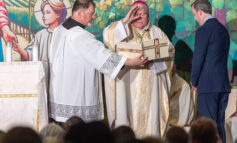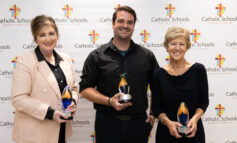By David Sedeño
The Texas Catholic
If you’re from Texas, chances are that you know the English translations for some common Spanish words such as hola, gato, perro, casa and agua.
For some students at the predominantly Hispanic Santa Clara of Assisi Catholic Academy in West Oak Cliff, the hope is that their introduction into a dual language immersion program will allow them to someday not only become bilingual and biliterate, but to have educational and socioeconomic opportunities that have eluded their parents or grandparents.
The diocese’s first dual-immersion language program was initiated last fall at Santa Clara through a partnership with Boston College’s Roche Center for Catholic Education, which launched the Two-Way Immersion Network for Catholic Schools in 2013, as a way to help students in Catholic schools learn and be successful in two languages. Santa Clara currently is one of 17 schools in the nationwide network.
At Santa Clara, 97 percent of the 201 students are Hispanic and more than 60 percent fall under the poverty line. To get started with the program, Principal Stephanie Matous and five Santa Clara teachers went to Boston College for a week-long training program that touched on all educational aspects of what they will face in the classroom and beyond. The Santa Clara teachers also have mentors at the University of Dallas who help guide them.
The Santa Clara program currently involves 65 students in Pre-Kindergarten through first grade. In subsequent years, the students will continue to have 50 percent of their day in English and 50 percent in Spanish.
“We felt the dual language program was necessary to give our students a leg up when they get to high school and college,” Matous said. “One of the things that is very important in the Spanish classroom is to make sure the students understand and are learning.”
For the young students, part of that curriculum involves interactive learning, such as song and dance, using video clips or putting activities on the Smartboard to increase student participation.
“When they are able to use more than one learning style, that’s when it really sinks in for the student and it really becomes an engaging activity,” she said.
Students learn to pronounce names in both English and Spanish and the staff has placed labels in both languages on objects, boards and charts in classrooms and throughout the school to help students better identify those items.
For some parents, like Andrea Molina who has one child in the program, it already has anecdotal success, but the hope for a better future is even brighter.
“I think it’s very important for their future mainly because of the job opportunities and it’s just better to know two languages,” she said. “Spanish is everywhere now. Knowing the language gives them a greater opportunity in life for the future.”
Patricia Weitzel-O’Neill, the executive director of the Roche Center in Boston and the former Catholic schools superintendent for the Archdiocese of Washington, D.C., said that Catholic schools were once known for educating new immigrants. “We built these schools to address the needs of the immigrant population and we did that for years and years, but somehow we forgot what we were here to do,” she said.
She said a global-centric mentality of educating students to communicate in more than one language should be the desire of church leaders, school administrators, parents, teachers and prospective employers.
“Catholic education today is our responsibility to do what we can to build the new models for the future,” she said. “We must be faithful to our gospel values and allowing children to seek the truth and to be educated in the way that is academically excellent. Being bilingual will enhance that academic excellence for the children who have the privilege of being in those schools.”
Kristin Melley, who directs the TWIN-CS project out of Boston College, said the network schools provide an opportunity for educators across the country to reach out to each other for solutions, but that more needs to be done overall.
“Our church is changing and our Catholic schools have a fundamental responsibility to provide the best academic and welcoming experience to all families who seek a Catholic education,” Melley said. “This is something that we feel is overdue.”
For now, Matous said pre-enrollment for next year is up by more than 10 percent and that Santa Clara administrators and teachers are in the process of writing their own dual language curriculum and hoping to one day become a model dual language school for the diocese.
“It’s been exciting that we are embracing both languages and with that,” she said, “we are seeing students succeed who before may have been at the bottom.”



